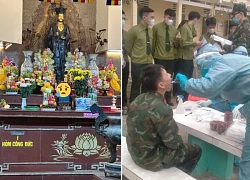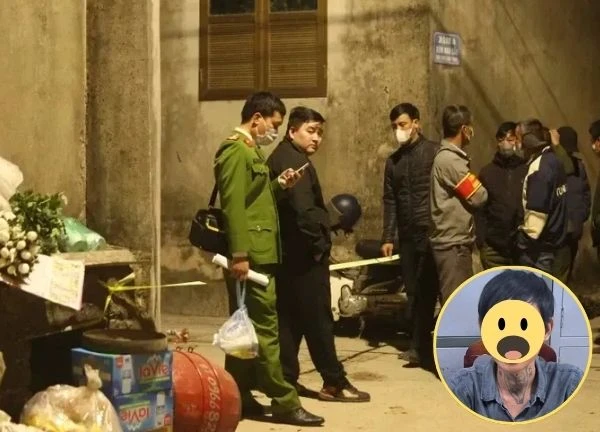The case of the U30 son 'going down' 2 times with his mother in Ha Giang: the cause of outrage?

3 | 0 Discuss | Share
The case of the departure of soldier Nguyen Van Nghiep has attracted public attention in recent days. On a number of social networking sites, distorted information appeared, negatively affecting the Army's agencies and units and the families of these soldiers.
The report of the 12th Regiment, 3rd Division, 1st Military Region said that Corporal Nguyen Van Nghiep (SN 3/10/2001, hometown in Dai Lam village, Tam Da commune, Yen Phong district, Bac Ninh province) enlisted in the army in early 2024, is an ordnance officer of the 1st Company, 4th Battalion, 12th Regiment, 3rd Division and in the same room as the company's military medical staff.
According to the unit's military doctor, at about 8 o'clock on February 9, 2025, Comrade Nghiep had a fever and abdominal pain, and was allowed to rest and monitor. By 18 o'clock on the same day, Nghiep continued to have an unbearably high fever, abdominal pain around the navel.
The commander decided to take him to the Regimental Infirmary, then transferred to the Divisional Infirmary for monitoring and treatment. Noticing that the signs still did not subside, at 22:50, the unit took Comrade Nghiep to the Emergency Department, Military Hospital 110. 1 hour later (23:50p), Nghiep was given oxygen, used the hospital's ambulance to be transferred to the 108th Military Central Hospital because his condition was beyond the ability to treat. At about 0:55 p.m., the 108th Military Central Hospital announced that soldier Nguyen Van Nghiep had died of cerebral palsy.
After receiving the information, the commander and agencies at all levels of the 12th Regiment reported to their superiors according to regulations, then notified Comrade Nghiep's family. The case was resolved in accordance with regulations.
In the report of the 108th Military Central Hospital, it is clearly stated: Patient Nguyen Van Nghiep was taken to the 108th Military Central Hospital at 0:36 on February 10; About 10 minutes earlier, the patient stopped circulating, was compressed, squeezed the balloon, transferred to the Emergency Department in a deep coma, Glasgow 3 points, dilated pupils on both sides by 4mm, loss of light reflexes, generalized necrotic rash, cold skin, carotid pulse could not be captured, blood pressure could not be measured. Diagnose the patient with out-of-hospital circulatory arrest, monitor for septic shock. The on-duty crew immediately treated advanced cardiopulmonary resuscitation (compression, intubation, adrenalin injection, nabica infusion), explained the condition of the severe patient to the unit commander and the accompanying unit medical unit.
However, the patient's condition did not improve, after a period of compression, the heart did not beat again. The duty crew informed the military medical unit about the possibility of the patient being infected with a dangerous infectious disease, and it was necessary to isolate the unit. After the results of the tests, the staff of the 108th Military Central Hospital consulted and concluded that patient Nguyen Van Nghiep stopped circulating outside the hospital because of acute meningococcal septic shock.
Colonel, Dr. Vu Viet Sang, Deputy Director of the Clinical Institute of Infectious Diseases, 108 Military Central Hospital said: The correct diagnosis of patient Nguyen Van Nghiep is acute meningococcal sepsis, complications of septic shock, and multi-organ failure.
Occupational disease is considered a very dangerous disease, caused by meningococcal bacteria, often known as lightning strikes, which has been widely recorded in medical literature.
In the case of soldier Nghiep, from 8 a.m. to midnight, he had all the symptoms of sepsis, septic shock, and multi-organ failure, including systemic hemorrhage. These are typical signs of hemorrhage due to meningococcal disease. This is a very dangerous disease, often appearing in young people. Within just 12-24 hours, patients with the disease can progress severely and then die.
When receiving the news from the unit, Comrade Nghiep's relatives because they were too sad had an angry attitude, excessive behavior and improper words. Some people have deduced that their children and grandchildren died because they were beaten by unit officials. They blatantly accused and slandered unit officials and the police to cover up the violation, even though there was no evidence.
This information was then shared arbitrarily, commenting in an inflammatory and negative tone, pushing the incident away and affecting the honor and reputation of the Army. The incident was distorted and taken advantage of by hostile forces to fight back.
The investigating agency also entered the case of Corporal Nguyen Van Nghiep and agreed with the family to conduct an autopsy from February 10. 2 days later, the Military Institute of Forensic Medicine issued a document providing preliminary information, determining the cause and time of death of Comrade Nghiep with the following main contents:
No damage was detected due to the impact of external forces (no skin rubbing, no blood bruises, no fractures, no joint errors...); many hemorrhagic rashes, necrosis throughout the body (head, face, neck, chest, abdomen, back, extremities); pleural effusion, peritoneum, and pericardium; congestive meninges, with pseudomembranes; cerebral edema, the surface of the cerebral hemisphere is tense; cerebrospinal fluid is pink; pulmonary edema...
The test results carried out by the 108th Military Central Hospital for Nghiep patients are as follows: CT of the brain does not show any images of intracranial abnormalities; CT of the chest: Imaging of right pleural fluid, pericardial fluid, pulmonary edema; blood test by Realtime PCR: Neisseria meninggitidis: positive.
Verdict: There are no signs of damage due to the impact of external forces. Cause of death: Respiratory failure, irreversible circulation in people infected with meningococcal disease.
The case of Military Zone 1 died, 7 military personnel were quarantined: revealing the cause in the brain, noisy social media  Bảo Yến2 months agoIn recent days, social networks have been abuzz with the news of the death of soldier Nguyen Van Nghiep. Many unfounded rumors related to this story have been spread, causing public confusion. Recently, Military Region 1 (QK1) has released official information about the incident.
Bảo Yến2 months agoIn recent days, social networks have been abuzz with the news of the death of soldier Nguyen Van Nghiep. Many unfounded rumors related to this story have been spread, causing public confusion. Recently, Military Region 1 (QK1) has released official information about the incident.

3 | 0 Discuss | Share

8 | 0 Discuss | Share

2 | 0 Discuss | Share

5 | 0 Discuss | Share

2 | 0 Discuss | Share

5 | 1 Discuss | Share

4 | 0 Discuss | Share

4 | 0 Discuss | Share

5 | 0 Discuss | Share

2 | 0 Discuss | Share

1 | 0 Discuss | Share

1 | 0 Discuss | Share









3 | 0 Discuss | Report